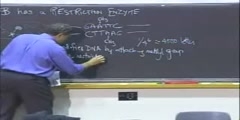Lec 3 - The Perfect Gas Law
"Lec 3 - The Perfect Gas Law" The Atmosphere, the Ocean and Environmental Change (GG 140) The Perfect Gas Law relates temperature, pressure, and density of gases in the atmosphere. It can be used to demonstrate why warm air rises, cool air sinks, and helium balloons float in the air. Buoyancy forces act in fluids (both water and air) when fluid is displaced by a parcel of a fluid with a different density. A combination of buoyancy force and the relationship given in the Ideal Gas Law govern the motion of parcels of gas in the atmosphere. 00:00 - Chapter 1. SI System of Units 09:55 - Chapter 2. Pressure and the Ideal Gas Law 20:39 - Chapter 3. Buoyancy Force 39:35 - Chapter 4. Composition of the Atmosphere 45:36 - Chapter 5. Density and Pressure Variations with Altitude Complete course materials are available at the Open Yale Courses website: http://oyc.yale.edu This course was recorded in Fall 2011.
Video is embedded from external source so embedding is not available.
Video is embedded from external source so download is not available.
Channels: Environmental engineering
Tags: Lec 3 - The Perfect Gas Law
Uploaded by: yaleatmoocenchng ( Send Message ) on 13-09-2012.
Duration: 51m 42s
Here is the next lecture for this course
The Perfect Face & Change the Sex of People
08:09 | 21364 viewsLec 19 - Subgame perfect equilibrium: mat ...
01:17:09 | 3322 viewsLec 107 - Factoring perfect square trinomials
04:54 | 2079 viewsLec 68 - Completing Perfect Square Trinomials
03:28 | 2620 viewsLec 19 - Perfect Inelasticity and Perfect ...
09:41 | 2893 viewsLec 50 - Perfect Competition
10:17 | 3173 viewsLec 20 - Subgame perfect equilibrium: war ...
01:15:37 | 3098 viewsLec 4 - Lecture 4 (Turbo) - Perfect Compe ...
01:17:46 | 2800 viewsPERFECT CREATION OF THE SKELETON 2
00:00 | 6524 viewsLec 6 - Nash equilibrium: dating and Cournot
01:12:06 | 3920 viewsLec 7 - Nash equilibrium: shopping, stand ...
01:11:21 | 3043 viewsLec 15 - Backward induction: chess, strat ...
01:12:39 | 3849 viewsLec 18 - Imperfect information: informati ...
01:15:58 | 3753 viewsRecombinant DNA Lecture 1
50:11 | 28347 viewsNo content is added to this lecture.
Lecture list for this course
Lec 1 - Introduction to Atmospheres
Lec 2 - Retaining an Atmosphere
Lec 4 - Vertical Structure of the atmosphere; Residence Time
Lec 5 - Earth Systems Analysis (Tank Experiment)
Lec 6 - Greenhouse Effect, Habitability
Lec 9 - Water in the Atmosphere I
Lec 10 - Water in the Atmosphere II
Lec 11 - Clouds and Precipitation (cloud chamber experiment)
Lec 12 - Circulation of the Atmosphere (Exam I review)
Lec 13 - Global Climate and the Coriolis Force
Lec 14 - Coriolis Force and Storms
Lec 18 - Seasons and Climate Classification
Lec 19 - Ocean Bathymetry and Water Properties
Lec 20 - Ocean Water Density and Atmospheric Forcing
Lec 22 - Ocean Currents and Productivity
Lec 24 - Ice in the Climate System
Lec 25 - Ice and climate change
Lec 26 - Isotope Evidence for Climate Change
Lec 28 - Global Warming (continued)
Lec 29 - Global Warming (continued)
Lec 30 - Climate Sensitivity and Human Population
Lec 31 - The Two Ozone Problems















